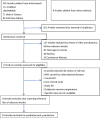Identification of functional near-infrared spectroscopy for older adults with mild cognitive impairment: a systematic review
- PMID: 40271185
- PMCID: PMC12014625
- DOI: 10.3389/fnagi.2025.1492800
Identification of functional near-infrared spectroscopy for older adults with mild cognitive impairment: a systematic review
Abstract
Objective: Mild cognitive impairment (MCI), a common state of cognitive impairment without significant impairment in daily functioning among older adults, is mainly identified using various neuropsychological tests, clinical interviews, and collateral history with some subjective interferences. This systematic review aimed to investigate the functional near-infrared spectroscopy (fNIRS) features of older adults with MCI compared with those with normal cognitive function to assist in the diagnosis of MCI.
Methods: A literature search was conducted in electronic databases, including PubMed, Web of Science, Embase, and Cochrane Library, up to June 15, 2024. The data on article information (first author and year of publication), participant characteristics, task paradigms, regions of interest (ROIs), fNIRS device attributes, and results related to cerebral oxygenation and hemodynamics were extracted.
Results: Finally, 34 relevant studies were identified, involving 1033 patients with MCI and 1107 age-, sex-, and education-matched controls with normal cognitive function. We found that the studies frequently used working memory-related task paradigms and resting-state measurements. Also, the prefrontal cortex was a primary ROI, and the changes in oxygenated hemoglobin concentration were the most basic research attributes used to derive measures such as functional connectivity (FC), FC variability, slope, and other parameters. However, ROI activation levels differed inconsistently between patients with MCI and individuals with normal cognition across studies. In general, the activation levels in the ROI of MCI patients may be higher than, lower than, or comparable to those in the normal control group.
Conclusion: Research on fNIRS in elderly patients with MCI aims to provide an objective marker for MCI diagnosis. The current findings are mixed. However, these differences can be partly explained with the theoretical support from the interaction of cognitive load theory and scaffolding theory of aging and cognition, taking into account factors such as unspecified MCI subtypes, task difficulty, task design, monitoring duration, and population characteristics. Therefore, future studies should consider definite MCI subtypes, strict and well-designed paradigms, long-term monitoring, and large sample sizes to obtain the most consistent results, thereby providing objective references for the clinical diagnosis of MCI in elderly patients.
Keywords: cerebral hemodynamics; cerebral oxygenation; functional near-infrared spectroscopy; mild cognitive impairment; systematic review.
Copyright © 2025 Yang, Deng, Qu, Li, Guo and Yu.
Conflict of interest statement
The authors declare that the research was conducted in the absence of any commercial or financial relationships that could be construed as a potential conflict of interest. The reviewer JL declared a shared affiliation with the authors BY, XD, XQ, YL, NY to the handling editor at the time of review.
Figures
Similar articles
-
Functional near-infrared spectroscopy reveals decreased resting oxygenation levels and task-related oxygenation changes in mild cognitive impairment and dementia: A systematic review.J Psychiatr Res. 2020 May;124:58-76. doi: 10.1016/j.jpsychires.2020.02.017. Epub 2020 Feb 22. J Psychiatr Res. 2020. PMID: 32120065
-
Screening tools for subjective cognitive decline and mild cognitive impairment based on task-state prefrontal functional connectivity: a functional near-infrared spectroscopy study.Neuroimage. 2025 Apr 15;310:121130. doi: 10.1016/j.neuroimage.2025.121130. Epub 2025 Mar 7. Neuroimage. 2025. PMID: 40058532
-
An exploration of distinguishing subjective cognitive decline and mild cognitive impairment based on resting-state prefrontal functional connectivity assessed by functional near-infrared spectroscopy.Front Aging Neurosci. 2025 Jan 8;16:1468246. doi: 10.3389/fnagi.2024.1468246. eCollection 2024. Front Aging Neurosci. 2025. PMID: 39845444 Free PMC article.
-
Diagnosis of Mild Cognitive Impairment Using Cognitive Tasks: A Functional Near-Infrared Spectroscopy Study.Curr Alzheimer Res. 2020;17(13):1145-1160. doi: 10.2174/1567205018666210212154941. Curr Alzheimer Res. 2020. PMID: 33583382
-
The Efficacy of Cognitive Intervention in Mild Cognitive Impairment (MCI): a Meta-Analysis of Outcomes on Neuropsychological Measures.Neuropsychol Rev. 2017 Dec;27(4):440-484. doi: 10.1007/s11065-017-9363-3. Epub 2017 Dec 27. Neuropsychol Rev. 2017. PMID: 29282641 Free PMC article.
References
-
- Ahn H. J., Chin J., Park A., Lee B. H., Suh M. K., Seo S. W., et al. (2010). Seoul neuropsychological screening battery-dementia version (SNSB-D): A useful tool for assessing and monitoring cognitive impairments in dementia patients. J. Korean Med. Sci. 25 1071–1076. 10.3346/jkms.2010.25.7.1071 - DOI - PMC - PubMed
-
- Albert M. S., DeKosky S. T., Dickson D., Dubois B., Feldman H. H., Fox N. C., et al. (2011). The diagnosis of mild cognitive impairment due to Alzheimer’s disease: Recommendations from the National Institute on Aging-Alzheimer’s Association workgroups on diagnostic guidelines for Alzheimer’s disease. Alzheimers Dement. 7 270–279. 10.1016/j.jalz.2011.03.008 - DOI - PMC - PubMed
-
- American Psychiatric Association [APA], (2013). “Neurocognitive disorders,” in Diagnostic and Statistical Manual of Mental Disorders, 5th Edn, (Arlington, VA: American Psychiatric Association; ), 591–643.
-
- Baik J. S., Ko M. H., Ko S. H., Min J. H., Choi J. K., Baek J. Y., et al. (2022). Assessment of functional near-infrared spectroscopy by comparing prefrontal cortex activity: A cognitive impairment screening tool. Alzheimer Dis. Associat. Disord. 36 266–268. 10.1097/WAD.0000000000000475 - DOI - PubMed
Publication types
LinkOut - more resources
Full Text Sources


